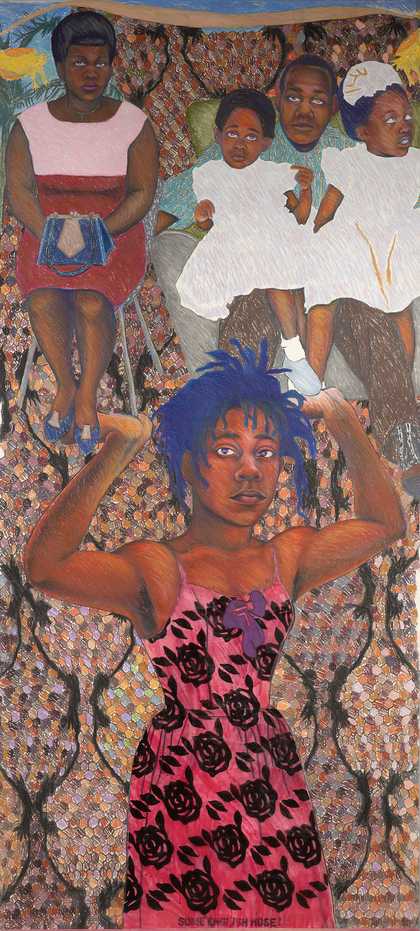‘What does it mean to think of, through, and with the Caribbean as method?’. In posing this question, the symposium built upon a rich tradition of conceptualising the Caribbean as not only a local geography, but an idea, an epistemological framework, a paradigm of global modernity and, in the words of co-organiser Paul Goodwin, ‘a manual in how to survive’ the uneven conditions of contemporary capitalism. This approach is not so much original (it does not need to be) as it is pressing, particularly as museums and universities internationally continue to rely on colonial conceptions of centre and periphery, frequently relegating the work of major Caribbean thinkers to the confines of regional curricula and narrow area studies.
In contrast, consent not to be a single being: Worlding Through Caribbean encouraged us to find in the work of the writers and theorists Édouard Glissant, Stuart Hall and Sylvia Wynter a blueprint for understanding the modern world. This triad (which could just as easily have included Franz Fanon, Aimé Césaire, or Paul Gilroy, among many others) partly reflects current enthusiasm for theoretical work that mobilises a critique of white supremacism while at the same time holds onto a relational ethos that in the symposium was described (via Gilroy) as ‘planetary humanism’.1 The stakes of this project should be understood in connection with a global crisis, the interlocking dimensions of which (from climate catastrophe and a deathly pandemic, to intensified migration, emboldened xenophobia and racialised terror, along with the sharpening of political divisions and their attendant culture wars) have cumulative effects along differential intersectional lines. Against this bleak context, the symposium made an invigorating plea to turn to the Caribbean as a ground for collective forms of resistance – as a model for ‘worlding’ not as neoliberal globalism but as existing differently together.
Crucially, the text-based methods provided by Glissant, Wynter, and Hall are rooted in a specific understanding of connectivity that allows for imaginative relations with people and places through archipelagic and diasporic affinities, but which also recognises the irreducible opacity of others, and, as Glissant foregrounds, the unknowability of one’s self. The centrality of these ideas was signalled by the title of the conference, which paid homage to a much-cited interview conducted by the filmmaker Manthia Diawara in which Glissant described the onset of the African diaspora as ‘the moment when one consents not to be a single being’ and ‘the passage from unity to multiplicity’.2 For Katherine McKittrick, whose keynote address opened the symposium, this departure from the safe ontological shores of the singularity constitutes an invaluable legacy.
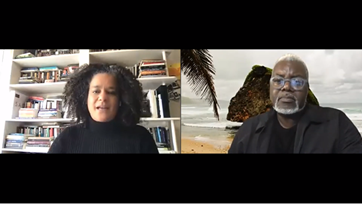
Katherine McKittrick and Paul Goodwin during the Q&A following McKittrick’s keynote for the symposium consent not to be a single being: Worlding through the Caribbean on 1 December 2021
Following a robust critique of current scholarship on Blackness and ecology, McKittrick invoked a ‘planetary humanism’ forged through a practice of reading with and through Wynter, Glissant, and Gilroy. Against the reinforcement of long-standing narratives in which Black people are stripped of personhood and turned into ‘toxic landscapes’, her attempt to ‘share an analytic that is committed to undoing harm rather than endlessly describing harm’ hinged upon two moves. First, she called for more nuanced engagements with the complexities of Black time, offering a critique of the (admittedly strategic) tendency to conflate regimes of racial terror in the present with the history of the colonial plantation, thereby suppressing key moments of resistance, liberation, and change. Here, as across the three days of the symposium, non-linear time was placed front and centre of what the Caribbean has to offer as a field of discourse, with McKittrick going as far as calling it ‘an analytical and methodological gift’.
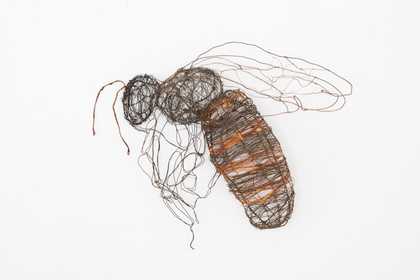
Charmaine Lurch
Leaf Cutter Bee 2014
mixed wire
1016 x 914 x 406 mm
© Charmaine Lurch
Another important strand in McKittrick’s talk concerned ‘Black Atlantic Livingness’ as a relational field capable of engaging multiscalar and multispecies experiences. Rejecting essentialist understandings of identity as singular and biologically constituted, McKittrick invited us to ‘enter into a conversation about our interhuman and extrahuman ecologies as curious beings’. An example of how this might be achieved was given in her closing remarks on Charmaine Lurch’s giant bee sculptures. Made of wire and other materials including wool, the artworks connote biotic nests, colonies and hives alongside electronic and financial circuits, appealing simultaneously to histories of science and literature as well as conjuring entanglements across multiple ontologies and chronotopes. Although bees have at times been read as metaphors for Black collectivity, migration and extinction, to associate them with one particular identity severely diminishes their capaciousness as analytic and ecological vessels. Ultimately, McKittrick invited the audience to imagine Lurch’s symbolisations as prompts for the kind of ‘sinuous’ spatio-temporal thinking required to engage the complexities of our planetary selves.
These reflections about the importance of emphasising the ‘livingness’ of experiential time over reified historical narratives, particularly when theorising Blackness and racialisation, found productive echoes across the conference. In her consideration of the Caribbean Festival of Arts (CARIFESTA), Adrienne Rooney returned to Wynter’s foundational conceptualisation of the plot or ‘provision ground’ as a life-affirming site nested within the enslaved experience of the plantation. Equally, Nicole Smythe-Johnson questioned the usefulness of Eurocentric conceptions of modernity when studying Caribbean art practices. At stake in these debates is the systematic effacement of ways of being and knowing that are not aligned with what McKittrick termed ‘market time’. As emphasised by Julia Hori in her study of postcolonial counter-monuments, Caribbean artists and philosophers are uniquely poised to explore how, to cite Glissant, ‘one of the most disturbing consequences of colonisation is the enshrinement of a single totalising history’.3
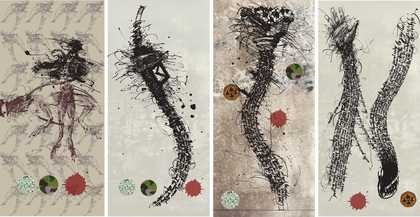
Christopher Cozier
Four panels from The Arrest: hands up, hand out 2013
Lightboxes, digital images on transparencies
Each image 850 x 413 mm
© Christopher Cozier
Other speakers similarly appealed to multiplicity. In Maica Gugolati and Christopher Cozier’s collaborative presentation, the artwork (as a privileged site of semantic opacity and poetic allusion) was offered as a nimble rebuttal against monodimensional conceptions of identity favoured by post-independence governments in the Caribbean, as much as by global art markets and in the academy (where, in McKittrick’s words, ‘Black objecthood is currency’). Specifically, in his art practice Cozier has used the trope of the bleacher to comment upon the disciplining of the body politic in the aftermath of independence on the island of Trinidad. This happened through public rituals such as parades and concerts, thus highlighting the spectacularised nature of citizenship after colonialism. In one particularly iconic sketch, the figure of a wriggling dancer celebrates slipperiness and ‘expediency’ in the face of these pressures. In the same panel, Ada Patterson used poetic language to speculate about a posthuman existence lived safely among starfish and gilded creatures, in a move to transcend the hostility that trans and queer people experience globally, but especially in the Caribbean. M. Ty also put forward a meticulous critique of the logic of speciation through images gleaned from the work of Sun Ra and Kara Walker; while Julian Henriques appealed to sound systems and dancehalls as prefiguring an entangled humanity along the lines of Wynter’s critique of Man.
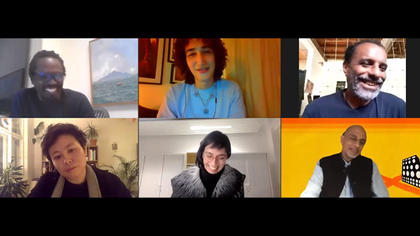
The first panel, ‘Human as Praxis’, of the symposium consent not to be a single being: Worlding through the Caribbean on 1 Decmber 2021: clockwise from top left – Wayne Modest, Ada M. Patterson, Christopher Cozier, Julian Henriques, Maica Gugolati and M. Ty
The panel on ‘Worlding’ sought to challenge the Atlanticist focus of much Caribbean Studies, allowing for vital conversations about the under-recognised role of East and South Asian migration into and out of the region. Alexandra Chang described processes of transition, transformation, and temporality in the work of Kathryn Chan and Nicole Awai, while Lee Xie illuminated the performance practice of Maria Magdalena Campos-Pons, who shares ancestral stories through fragmentary, sometimes oceanic, compositions. The panel provided opportunities to test the extent to which Glissant and Wynter might be relevant to other diasporic contexts, as in Nidhi Mahajan and Moad Musbahi’s deployment of creolisation and relationality in the Arabian peninsula. Along with other papers that invoked creolised archives – including Sarah Phillips Casteel’s discussion of the work of Josef Nassy and Alpesh Kantilal Patel’s transnational investigation of the votive pathways of the Black Madonna – these interventions proposed to ‘Caribbeanise the world’ (Henriques) in recognition of theories that have long presented the region as a microcosm of the globe.
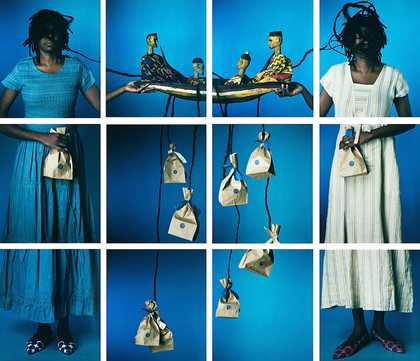
Maria Magdalena Campos-Pons
De las dos aguas (Between Two Waters) 2007
© Maria Magdalena Campos-Pons
Problematic here is how notions of cosmopolitanism and relationality can unwittingly become rationales for disengaging with the specificities of the Caribbean as an embodied space. This criticism was mobilised by audience members who questioned the lack of participants working from within the region. If such comments appeared to overlook the theoretical premises of the symposium, they also drew attention to the uneven geopolitics that govern institutional circuits of knowledge production and their attendant art markets. As acknowledged by Goodwin in the concluding remarks, if the world is to be Caribbeanised it is vital that careful attention is paid to which networks of vision and knowledge are platformed internationally, but especially in the hegemonic context of Great Britain.
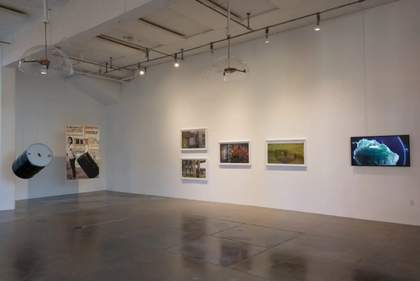
Roshini Kempadoo
Like Gold Dust 2019 installed at Artpace, San Antonio
© Rohini Kempadoo
Against this backdrop, the ecological thread that ran through the symposium provided welcome opportunities for holding regional and planetary concerns in tension. This was the case in Roshini Kempadoo’s talk about Like Gold Dust, their multimedia installation first presented at Artpace San Antonio. Drawing on Wynter’s concept of political praxis as ‘hybrid-auto-instituting-languaging-storytelling’, the artist sampled, fictionalised, and reperformed the voices of Black and First Nation women activists who are at the forefront of resistance against the violence of the petro-chemical industry in Guyana and Texas.
‘Planetary Sensing’, an artistic research project on bioluminescence, similarly engaged with the question of how art might intervene within the field of environmental activism.4 Taking as a starting point the endangerment of the dinoflagellates (bioluminescent algae) of Oyster Bay, Jamaica, artist Susanne M. Winterling, in collaboration with attorney-at-law Laleta Davis-Mattis and director of the Social Justice Institute Denise Ferreira da Silva, proposed a Bill of Rights of Nature that would bypass the distinction between human and non-human life. Building on the links between these projects and Guillermina De Ferrari’s examination of hospitality as a strategy for surviving hostile social environments (specifically post-dictatorship Cuba), the final discussion on ecology chaired by Daniella Rose King raised particularly generative questions around cohabitation, interdependency, artmaking, and storytelling as strategies for both witnessing and imagining different worlds.
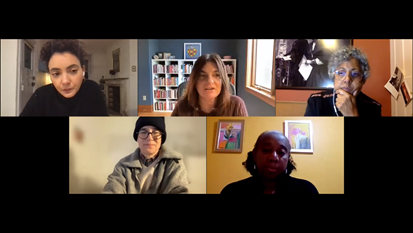
The fifth panel, ‘Ecology’, of the symposium consent not to be a single being: Worlding through the Caribbean on 3 December 2021: clockwise from top left – Daniella Rose King, Guillermina de Ferrari, Roshini Kempadoo, Laleta Davis-Mattis and Susanne M. Winterling
Art and its curation emerged throughout the conference as critical sites of worlding, in keeping with the ethos of the theorists who inspired the event. As Gilane Tawadros explored in her presentation on Stuart Hall – one of the few papers that closely engaged with the legacy of the Jamaican British author – these writers sought every opportunity to collaborate with artists and art institutions (in Hall’s case, Tawadros foregrounded the relation with Isaac Julien). Visual practice did not just illustrate their ideas, but actively furthered their thinking around issues of identity and environment. The way that these legacies are then reinscribed within public culture (i.e. museums, conferences, teaching and so on) is a vital area for future interrogation.
Drawing directly on Glissant, curator and researcher Natalie McGuire-Batson offered a relational model for Caribbean museology. Her approach puts community at the forefront of all museum activities, while acknowledging that identities are not fixed. Instead, in their continuous ‘unlearning’ of colonial epistemologies, museum workers must always operate within a multivocal ecology with accessible and reflexive research outputs. Given the persistence of denial and misinformation around the history and institutional legacy of European colonialism, it is especially important to cultivate radical pedagogical practices, in the Caribbean as across the Atlantic. This was the focus of Malini Guha who spoke of the need for collaborative reading and ‘hungry listening’, a concept derived from the work of Dylan Robinson as well as resonating with more well-known writings by Fred Moten and Stefano Harney.5 Avoiding performative engagements with decolonisation (frequently signalled by the provision of reading lists) Guha foregrounded art practices that make tangible space for intergenerational reading practices.
As Tawadros noted, ‘it is not enough to imagine a new world – we have to bring it into being’. Radical reading practices are central to how the symposium approached this task. From the outset, McKittrick posited that reading with and through the work of major Caribbean thinkers might unlock ‘lessons in how to theorise, and perhaps more fully realise, our planetary hopes’. While it is vital not to lose sight of the region as a lived space, consent not to be a single being demonstrated that there are very rich possibilities for framing the Caribbean as method. Importantly, the heterochronic approaches offered within the work of Glissant, Wynter and Hall demand an awareness of the experience of the past and future within the present, as well as a refusal of notions of territory and territorialisation in favour of a more ‘restless relation to land’ (McKittrick). It is by cultivating these lessons that we may begin to foster alternative forms of cooperative listening, learning, displaying and perhaps, even, new methods for being-in-the-world.
Kate Keohane and Giulia Smith are Early Career Research Fellows at the Ruskin School of Art, University of Oxford

